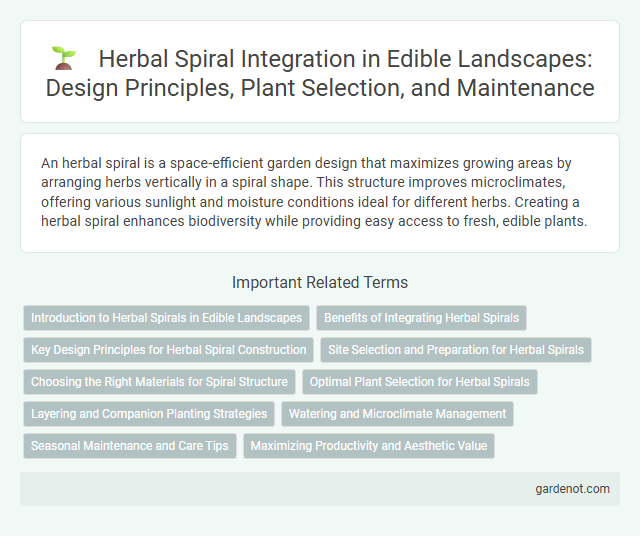An herbal spiral is a space-efficient garden design that maximizes growing areas by arranging herbs vertically in a spiral shape. This structure improves microclimates, offering various sunlight and moisture conditions ideal for different herbs. Creating a herbal spiral enhances biodiversity while providing easy access to fresh, edible plants.
Introduction to Herbal Spirals in Edible Landscapes
Herbal spirals are space-efficient garden designs that maximize microclimates for diverse herb cultivation in edible landscapes. Constructed with a raised spiral bed, they create varied moisture and sunlight zones, ideal for growing Mediterranean, temperate, and moisture-loving herbs together. This sustainable technique enhances biodiversity while offering easy access to fresh culinary and medicinal herbs.
Benefits of Integrating Herbal Spirals
Integrating herbal spirals into edible landscapes maximizes space by creating vertical growing areas that support diverse plant varieties in compact spaces. These spirals enhance microclimates through varying sun, shade, and moisture conditions, promoting optimal growth for herbs with different needs. The design also encourages biodiversity, attracts beneficial insects, and simplifies access for harvesting and maintenance.
Key Design Principles for Herbal Spiral Construction
Key design principles for herbal spiral construction include maximizing vertical space to accommodate diverse plant heights and sunlight requirements, incorporating a central drainage system to prevent waterlogging, and using porous materials like rocks for heat retention and root aeration. The spiral's curved shape enhances microclimates by creating varied moisture and light levels, supporting different herbs' growth needs. Strategic layering ensures easy access for harvesting and maintenance while optimizing soil depth and quality for plant health.
Site Selection and Preparation for Herbal Spirals
Choosing a well-drained, sunny location with good air circulation enhances the growth of diverse herbs in an herbal spiral. Preparing the site involves clearing debris, loosening soil to improve aeration, and enriching it with organic matter like compost to support nutrient-demanding plants. Elevating the spiral's core helps create microclimates, optimizing moisture retention and sun exposure for a variety of herbs.
Choosing the Right Materials for Spiral Structure
Selecting the right materials for an herbal spiral structure involves using durable, natural elements like stones, bricks, or reclaimed wood to ensure stability and longevity. These materials should provide good drainage and thermal mass to create microclimates that support diverse herb growth. Incorporating porous and eco-friendly materials enhances soil health and promotes sustainable water retention within the edible landscape.
Optimal Plant Selection for Herbal Spirals
Optimal plant selection for herbal spirals includes drought-tolerant herbs like rosemary, thyme, and sage at the top, where sunlight and drainage peak. Mid-level sections benefit from moderately moist herbs such as mint, chives, and parsley that thrive in partial shade and balanced moisture. Lower spiral areas with richer soil and more moisture suit water-loving plants like basil, cilantro, and lemon balm, enhancing biodiversity and maximizing space efficiency within the edible landscape.
Layering and Companion Planting Strategies
Herbal spirals maximize space through vertical layering, creating microclimates that support diverse herb growth from water-loving plants at the base to drought-tolerant herbs at the top. Companion planting strategies in herbal spirals enhance pest control, improve pollination, and promote nutrient exchange by strategically placing herbs like basil near tomatoes and chives next to carrots. This integration boosts overall plant health and yield while optimizing soil use and biodiversity.
Watering and Microclimate Management
Herbal spirals maximize water efficiency by directing runoff from higher to lower levels, reducing the need for frequent irrigation. The spiral design creates diverse microclimates, with sun-exposed upper sections favoring drought-tolerant herbs and shaded lower areas supporting moisture-loving plants. This strategic arrangement enhances water retention and optimizes growth conditions for a variety of herbs in a compact space.
Seasonal Maintenance and Care Tips
Seasonal maintenance of a herbal spiral includes regular pruning to encourage new growth and prevent overcrowding of herbs such as rosemary, thyme, and basil. Mulching with organic compost helps retain moisture while suppressing weeds, especially during dry summer months. Winter protection involves insulating tender herbs like oregano and mint with straw or frost cloth to ensure survival through freezing temperatures.
Maximizing Productivity and Aesthetic Value
A herbal spiral maximizes productivity by utilizing vertical space to plant diverse herbs with varying water, sunlight, and soil requirements, promoting efficient growth in a compact footprint. Its layered design enhances aesthetic value by creating a visually appealing spiral shape that adds texture and color to edible landscapes. Incorporating drought-tolerant and shade-loving herbs at different spiral levels increases biodiversity, yielding a functional and beautiful garden feature.
Herbal spiral Infographic

 gardenot.com
gardenot.com